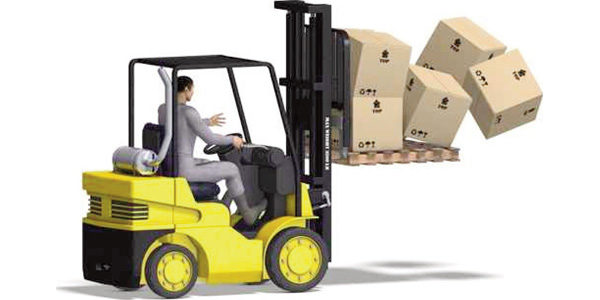Training, enforcement called key to reducing forklift accidents

The lift truck is the workhorse of the distribution center, touching product from receiving to putaway and picking through loading onto the outbound trailer. But as a piece of heavy equipment capable of moving at high speeds and controlled by fallible human beings, the lift truck can also be dangerous.
Forklift accidents remain one of the leading causes of deaths and injury in U.S. workplaces, with an estimated 100 workers killed and 20,000 injured each year. The U.S. Occupational Safety and Health Administration (OSHA) says on its Web site, "Each year, tens of thousands of injuries related to powered industrial trucks or forklifts, occur in U.S. workplaces. Many employees are injured when lift trucks are inadvertently driven off loading docks, lifts fall between docks and an unsecured trailer, they are struck by a lift truck, or when they fall while on elevated pallets and tines. Most incidents also involve property damage, including damage to overhead sprinklers, racking, pipes, walls, and machinery."
The result is a high cost in human suffering and potentially enormous costs to companies in worker compensation, lost productivity, litigation, and damage to trucks, property, and product. "This is important not only from a moral standpoint but from a cost standpoint," says David Hoover, president of Newark, Ohio-based Forklift Training Systems.
Human error
As for the cause of the problem, people sometimes assume that faulty equipment is to
blame. But that's rarely the case these days, according to Hoover. "The issue of bad equipment
has by and large gone by the boards," he says.
In fact, Hoover says, recent technical advances have made today's lift trucks safer than ever. He cites the examples of the tilt and mast controls in Toyota's three-wheel electric truck lineup that reduce spilled loads and truck turnovers, and Crown Equipment Corp.'s controls that prevent a truck from operating if a driver's foot is outside the cab area.
Even so, the problem persists. Why? In OSHA's view, the cause generally lies in human error. On its Web site, the agency says: "[M]ost employee injuries and property damage can be attributed to lack of safe operating procedures, lack of safety-rule enforcement, and insufficient or inadequate training."
Hoover agrees that poor training and lack of enforcement are at the core of the problem. "I've seen a lot of training done poorly," he says. For one thing, he says, many of the training programs available are generic, without reference to specific equipment or operating conditions.
But the problem goes beyond the programs themselves, Hoover says. There's also the issue of who's getting training and how much training they're getting. Hoover believes many companies provide inadequate instruction to inexperienced drivers. "If you bring in a good employee with no experience, you have to build a driver," he says. "The more seat time you get them, the better."
Employees who work in the vicinity of the forklifts often get the short shrift as well, Hoover says. "We spend time and money on [instruction for] drivers, but there's often not training for working around forklifts," he says. "You need to provide awareness training, and you can do it in half an hour."
Hoover, who offers forklift training programs to operations of all sizes, advocates a more holistic approach that includes site visits and observations. He says that he insists on talking to facility managers, examining incident reports and safety records, and observing operations as a starting point. He looks for simple things such as whether lift-truck operators are required to wear seat belts and how strictly supervisors enforce the rules.
Mike Angelini, who oversees customer training for lift-truck maker Raymond Corp., says his company takes a similar approach. "We like to do an observation and want to talk to the folks that run an operation," says Angelini, who is the company's manager of marketing communications and education. "We want to know what happens from the time someone is hired. The other thing we do is walk the area. We want to make sure what drivers experience is not aggravated by the environment."
Get tough
While inadequate training may be a big factor in forklift accidents, it's only part of the story,
according to Hoover. Another problem is lax supervision, he says. Hoover believes that
operating managers are often not tough enough about enforcing good operating practices. "One of
the biggest problems I see is that management teams do not enforce the correct things,
and that is killing people," he contends. "They are too casual about enforcing rules."
Hoover says a lack of clarity about management's rights and responsibilities may be partly to blame. "Some [managers] say it is not their business if the truck driver wears a seatbelt," says Hoover, who often provides expert testimony in court cases involving lift-truck accidents. "But it is the company's business. You expect certain things from workers—to be on time, to be clean and sober. You can also expect them to operate safely, control their speeds, and wear their seatbelts. If they don't do it, you discipline them, and if they still don't do it, you cut them loose. Enforcement is part of management."
Hoover has no patience with supervisors who try to pass off responsibility for safety. "We hear a lot of supervisors who say they are not the safety person, that their job is to get product out the door. But if you have 10 people working for you, you are responsible for making sure your people go home safe, and that includes addressing [safety] issues directly."
He also dismisses the idea that demands for keeping goods moving sometimes require compromises in safety. Good equipment, appropriate technology, thorough training, and strict enforcement of safety rules enhance rather than detract from getting goods out the door safely and efficiently, Hoover argues. "Companies can be world class in productivity and safe at the same time," he says.
The latest lift-truck safety technologies aren't always found on the trucks themselves. Nowadays, safety innovations are just as likely to come in areas like the fleet management systems used to monitor trucks and drivers, or in equipment designed for the loading dock.
For example, in December, Crown Equipment Corp. released an update of its InfoLink fleet management system with several new safety features. These include tools to lock out drivers whose certifications have expired and to force drivers to complete a safety checklist before starting up the truck. The system allows each truck to be programmed to control speeds so, for instance, a novice driver can be held to slower speeds than more experienced operators. The updated software also features an enhanced impact sensing system, according to Maria Schwieterman, marketing product manager for the company's Insite Productivity Suite (which includes the InfoLink system).
Raymond Corp. too has incorporated speed-control features into its fleet management system. The company's iWarehouse solution includes a module that lets managers remotely set speed limits on individual trucks. "You can change the specs as operators become more experienced to allow the driver to be more productive," says Joseph LaFergola, Raymond's marketing manager for business and information solutions. "Or you can ratchet down performance for drivers not operating within the guidelines. If you notice a lot of damage or impacts, you can give a driver a probationary period."
As for safety technologies designed for the loading dock, one example is Rite Vu, a new warning light system from Rite-Hite, a maker of loading dock safety systems. The Rite Vu system alerts dock personnel when a forklift is inside a trailer, and provides forklift drivers with visual assurance that the truck they're about to enter (or have already entered) is securely attached to the dock. "We're concentrating on signaling and communication," says Joe Manone, the company's vice president of marketing.
Related Articles

Copyright ©2024. All Rights ReservedDesign, CMS, Hosting & Web Development :: ePublishing